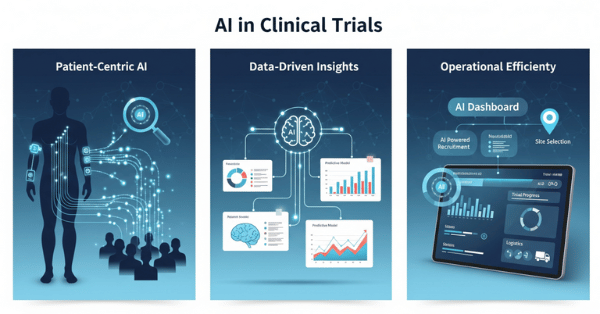Quantum AI Accelerates Drug Discovery: How Physics is Revolutionizing Pharmaceutical Research
The pharmaceutical industry faces a daunting challenge: developing life-saving drugs takes an average of 10-15 years and costs over $2 billion per medication brought to market. Traditional computational methods, while advanced, hit fundamental limitations when modeling the quantum-level interactions that govern how drugs work in the human body. However, a revolutionary fusion of quantum computing and artificial intelligence is poised to transform drug discovery, potentially reducing development timelines from decades to years.

The Quantum Advantage in Molecular Simulation
At its core, drug discovery is about understanding how molecules interact. Every biological process, from protein folding to drug binding, operates according to quantum mechanical principles. Classical computers, which use binary 1s and 0s, struggle to accurately simulate these quantum phenomena because they must approximate complex molecular behaviors rather than model them directly.
Quantum computers operate fundamentally differently. By leveraging quantum mechanical properties like superposition and entanglement, they can naturally simulate molecular systems as they actually exist in nature. This represents a paradigm shift from mathematical approximation to physics-based modeling.
McKinsey estimates that quantum computing could create $200-500 billion in value for the life sciences industry by 2035, primarily through more accurate molecular simulations that dramatically reduce the need for lengthy laboratory experiments.
Breakthrough Applications Already Showing Results
Real-World Quantum Drug Discovery Success
The most compelling evidence of quantum AI’s potential comes from actual pharmaceutical applications producing measurable results:
AstraZeneca’s 20x Speed Improvement: In a landmark collaboration with IonQ, AWS, and NVIDIA, AstraZeneca demonstrated quantum-accelerated computational chemistry that achieved over 20-fold improvement in simulation time for the Suzuki-Miyaura reaction, a critical process in small-molecule drug synthesis. This hybrid quantum-classical workflow integrated IonQ’s Forte quantum processor with GPU acceleration, reducing computation times from months to days.
First Quantum-Discovered Drug Candidates: Researchers used a quantum-classical generative model trained on IBM’s 16-qubit quantum computer to design novel KRAS inhibitors for cancer therapy. Among 15 synthesized candidates, two molecules (ISM061-018-2 and ISM061-22) demonstrated effective target engagement, with ISM061-018-2 showing broad-spectrum KRAS inhibition at 1.4 μM binding affinity. This marked the first time a quantum-generative model yielded experimentally confirmed biological hits.
Precision Protein Folding Predictions
Quantum algorithms are revolutionizing protein structure prediction, a cornerstone of drug design. Researchers from Cleveland Clinic and IBM successfully demonstrated quantum-enhanced protein folding by accurately predicting the structure of a Zika virus protein fragment. Their hybrid quantum-classical framework outperformed traditional methods and required no extensive training data, showcasing quantum computing’s ability to simulate protein behavior from first principles.
The Nature Scientific Reports published research showing quantum computers can handle protein folding models with O(N⁴) scaling for N amino acids, making previously intractable folding problems computationally feasible. This enables accurate modeling of complex proteins involved in diseases like Alzheimer’s and cancer.
Industry Partnerships Driving Practical Applications
Major pharmaceutical companies are investing heavily in quantum-AI drug discovery platforms:
Roche-Cambridge Quantum Computing: Roche partnered with Cambridge Quantum Computing in a multi-year collaboration using the EUMEN quantum chemistry platform for Alzheimer’s disease research. The partnership employs quantum algorithms to simulate atomic behavior during drug absorption and formation, targeting one of medicine’s most challenging diseases.
IBM’s Quantum Network: IBM has established quantum computing partnerships with Cleveland Clinic (featuring the world’s first on-site quantum computer for biomedical research) and Moderna (exploring quantum simulations for next-generation mRNA vaccines). These collaborations focus on screening and optimizing drug molecules against specific protein targets.
Johnson & Johnson’s Optimization Focus: J&J is collaborating with Pasqal to demonstrate quantum computing solutions for pharmaceutical optimization problems spanning clinical trials, logistics, and molecular design. As Herman Van Vlijmen from J&J noted, “optimization problems are everywhere” in pharmaceuticals, from drug candidate selection to supply chain management.
Technical Breakthroughs Enabling Practical Applications
Hybrid Quantum-Classical Architectures
The most successful quantum drug discovery applications employ hybrid systems that combine quantum and classical computing strengths. Quantum processors handle the computationally intensive molecular simulations, while classical systems manage data processing and optimization. Research published in Nature Scientific Reports demonstrated these hybrid approaches can achieve 93.5% accuracy compared to 78.2% for purely classical methods.
Quantum Machine Learning for Drug Properties
Quantum neural networks are showing superior performance in molecular property prediction. Studies published in Machine Learning: Science and Technology demonstrated quantum machine learning frameworks for virtual screening that outperformed classical algorithms on real-world drug databases, including COVID-19 and ADRB2 datasets. The quantum approach showed particular advantages in feature selection and pattern recognition for complex molecular structures.
Advanced Quantum Algorithms
Grover’s Algorithm Enhancement: Researchers developed enhanced versions of Grover’s quantum search algorithm specifically for protein folding and drug discovery, incorporating Quantum Binary Neural Networks (QBNN) to improve search precision. These algorithms scale with quantum hardware improvements, becoming more powerful as quantum computers advance.
Variational Quantum Eigensolvers (VQE): VQE algorithms can accurately determine molecular ground states and binding energies essential for drug design. Combined with machine learning techniques, VQE approaches enable precise prediction of drug-target interactions and off-target effects.
Addressing Traditional Drug Discovery Bottlenecks
Molecular Interaction Modeling
Traditional computers struggle with the exponential scaling of molecular interactions. A molecule with just 100 atoms can exist in over 10³⁰ possible configurations. Quantum computers handle this complexity naturally through superposition, simultaneously evaluating multiple molecular configurations.
Protein Hydration Analysis
Pasqal and Qubit Pharmaceuticals demonstrated breakthrough quantum algorithms for analyzing protein hydration – how water molecules influence drug binding within protein pockets. This quantum-powered analysis provides critical insights into drug effectiveness that classical methods miss, particularly for buried or occluded binding sites.
Electronic Structure Calculations
Quantum computers excel at modeling electronic structures that determine molecular behavior. Boehringer Ingelberg partnered with PsiQuantum to calculate electronic structures of metalloenzymes critical for drug metabolism. These calculations provide unprecedented detail about how drugs are processed in the human body.
Quantum vs Classical Drug Discovery Timeline

Current Limitations and Future Outlook
Technical Challenges
Current quantum computers operate in the Noisy Intermediate-Scale Quantum (NISQ) era, characterized by limited qubit counts and high error rates. However, rapid hardware advances are expanding capabilities. The IBM Qiskit platform now supports drug discovery applications with over 70 research teams from 65+ organizations participating in quantum drug discovery challenges.
Scalability Considerations
Research published in Physical Review Research analyzed resource requirements for quantum protein folding algorithms, finding that while qubit requirements fall within current capabilities, gate counts remain challenging. However, advances in quantum error correction and increased qubit stability are addressing these limitations.
Integration with Existing Workflows
Successful quantum drug discovery requires seamless integration with existing pharmaceutical R&D pipelines. Companies like SEEQC received £6.85 million funding to develop application-specific quantum computers for drug discovery, focusing on photodynamic cancer therapies where classical computing alone cannot provide adequate simulations.
Transformative Impact on Healthcare
Accelerated Therapeutic Development
Quantum-enhanced drug discovery could dramatically reduce the time between disease identification and treatment availability. By enabling accurate prediction of drug properties, toxicity, and efficacy through simulation rather than extensive laboratory testing, quantum approaches could streamline clinical trial design and reduce failure rates.
Personalized Medicine Advancement
Quantum computing’s ability to analyze complex, high-dimensional genomic datasets enables more sophisticated personalized medicine approaches. Quantum algorithms can identify patient-specific drug responses and optimize treatment protocols based on individual genetic profiles.
Addressing Rare Diseases
For rare diseases where limited patient populations make traditional clinical trials challenging, quantum simulations could provide alternative pathways for drug validation, potentially bringing treatments to underserved patient populations faster and more cost-effectively.
The Road Ahead
As quantum hardware continues advancing and quantum-AI algorithms become more sophisticated, the pharmaceutical industry stands on the brink of a computational revolution. The convergence of quantum computing’s natural ability to simulate molecular systems with AI’s pattern recognition capabilities creates unprecedented opportunities to accelerate drug discovery and improve human health outcomes.
The transition from proof-of-concept demonstrations to operational quantum-enhanced drug discovery platforms represents one of the most promising near-term applications of quantum technology, with the potential to transform how humanity develops life-saving medications.






